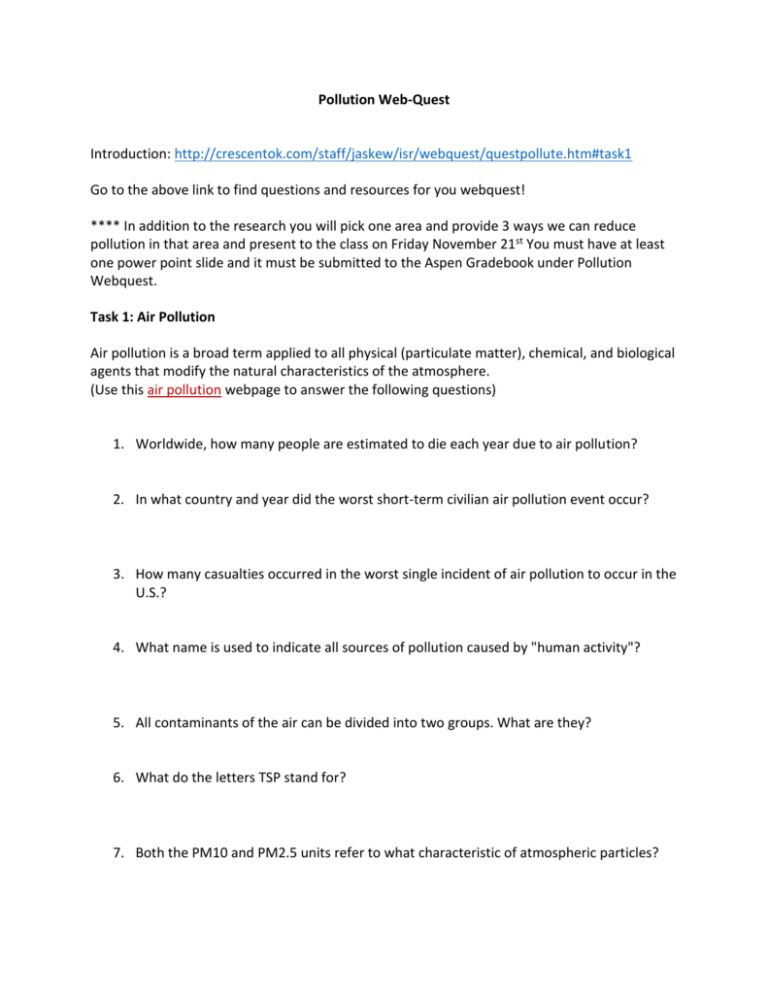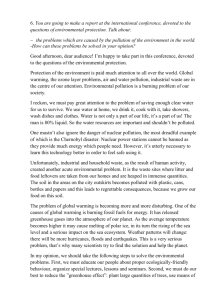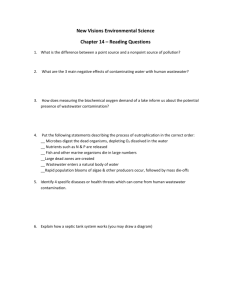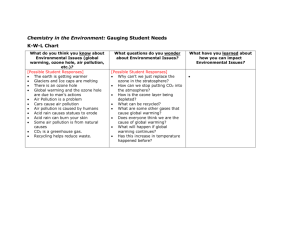Pollution Web-Quest: Air, Water, Noise, Global Warming
advertisement

Pollution Web-Quest Introduction: http://crescentok.com/staff/jaskew/isr/webquest/questpollute.htm#task1 Go to the above link to find questions and resources for you webquest! **** In addition to the research you will pick one area and provide 3 ways we can reduce pollution in that area and present to the class on Friday November 21st You must have at least one power point slide and it must be submitted to the Aspen Gradebook under Pollution Webquest. Task 1: Air Pollution Air pollution is a broad term applied to all physical (particulate matter), chemical, and biological agents that modify the natural characteristics of the atmosphere. (Use this air pollution webpage to answer the following questions) 1. Worldwide, how many people are estimated to die each year due to air pollution? 2. In what country and year did the worst short-term civilian air pollution event occur? 3. How many casualties occurred in the worst single incident of air pollution to occur in the U.S.? 4. What name is used to indicate all sources of pollution caused by "human activity"? 5. All contaminants of the air can be divided into two groups. What are they? 6. What do the letters TSP stand for? 7. Both the PM10 and PM2.5 units refer to what characteristic of atmospheric particles? 8. What group of air pollutant gases destroy the stratospheric ozone layer? 9. What group of air pollutant gases causes acid rain? 10. Two pollutants sometimes found in shower water mist are damaging to inhale. What are they? 11. How many lung cancer deaths are estimated annually in the U.S. by second-hand tobacco smoke? 12. How do pets contribute to indoor air pollution? Task 2: Water Pollution Water pollution has many sources and characteristics. Humans and other organisms produce bodily wastes which enter surface waters like rivers, lakes, and oceans. Industries discharge a variety of compounds such as heavy metals, and wastewater. Silt-bearing runoff from construction sites and farms can inhibit the penetration of sunlight through the water, hampering photosynthesis. Part A: Use this sewage treatment webpage to answer the following questions. 1. What are the two products of sewage treatment? 2. What is removed during "primary" wastewater treatment? 3. What is removed during "secondary" wastewater treatment? 4. What is the purpose of "tertiary" wastewater treatment? 5. What machine is used for primary sewage treatment? 6. Secondary treatment in most municipal sewage plants involves an aerobic process. What two things do the biota require? 7. Several processes can be used for tertiary treatment. When does disinfection occur? Part B: Use this industrial wastewater treatment webpage to answer the following questions. 1. What two contaminants are usually found in the water used to cool blast furnaces? 2. What two acids are commonly used in the iron and steel industry? 3. What are the principal waste-waters associated with mines and quarries? 4. What is required for the processing of food from raw materials? 5. Toxic metals can often be precipitated out of waste water by changing what? Part C: Use this agricultural wastewater treatment webpage to answer the following questions. 1. Where is a common place where the agricultural waste is in the form of a liquid slurry? 2. Why does disposal of wastewater containing animal waste upstream of a drinking water intake possibly pose serious health problems? 3. What is "silage" made up of? 4. What is "silage" made from? 5. Why does animal "dipping" cause a major pesticide runoff problem? 6. What pollutants are found in milking parlour wash-down water? Task 4: Noise Pollution Noise pollution is unwanted man-made sound that penetrates the environment. Use this noise pollution webpage to answer the following questions. 1. How does military SONAR kill marine mammals? 2. What is infrasonic sound? 3. What type of noise pollution escalated rapidly in the late 1990s? 4. What "urban legend" is mentioned in the reading? 5. What authorities are usually responsible for protecting against noise? 6. What two US cities have a law allowing impounding of cars with loud stereos? 7. What percentage of people bothered by noise will file an official complaint? Task 5: Global Warming Global warming describes an increase in the average temperature of the Earth's atmosphere and oceans. Use this global warming webpage to answer the following questions. 1. Over the past century, global (land and sea) temperature has increased by how much? 2. How long has it taken for atmospheric levels of carbon dioxide to increase by 31%? 3. Some think that even if levels of greenhouse gases were to remain constant, the global climate will warm by 0.5 oC to 1.0 oC. What would cause this? 4. There is a natural greenhouse effect without which the Earth would be uninhabitable. How much lower would Earth's temperature be with this natural effect? 5. How many billions of tons of carbon dioxide and other greenhouse gases are added to the Earth's atmosphere each year by burning fossil fuels? 6. How many millions of tons of methane are added to the Earth's atmosphere by human sources? 7. Some researchers have proposed that changes in the Sun, along with feedbacks from clouds and other processes, contribute to global warming. What is the name of this theory? 8. The amount of predicted global warming varies from one computer climate model to another. What probably causes this? 9. What potent greenhouse gas is trapped in large quantities in the permafrost of the tundra? 10. Global warming from CO2 radiative forcing is expected to cool the stratosphere. What effect will this have on ozone depletion? 11. Some scientists seem to have observed a reduction in the amount of sunlight reaching the surface of the planet, possibly due to aerosols. What is this phenomenon called? 12. The primary effect of global warming is increasing carbon dioxide and increasing global average temperature. List four secondary effects of global warming. 13. What eight countries would be most affected by sea level rise from global warming? Task 6: Environmental Protection Agency This task introduces the EPA, the US government agency responsible for protecting the environment. Use this Environmental Protection Agency webpage to answer the following questions. 1. What do the letters FIFRA stand for? 2. EPA tests for automobile fuel economy do not measure actual fuel consumption. What do they measure? 3. What type of vehicles have the most significant differences between the EPA mileage rating and actual mileage? 4. In what year was the "Scenic Rivers Preservation Act" passed? 5. Which EPA region includes Georgia?





